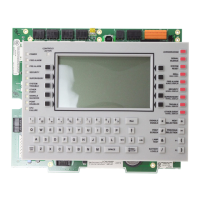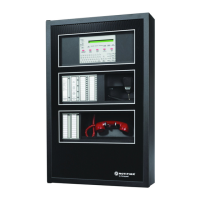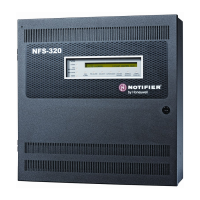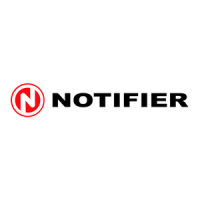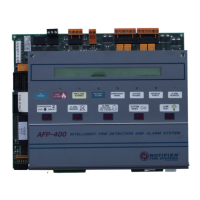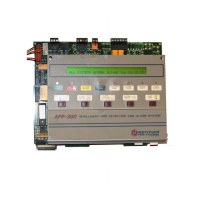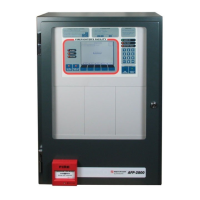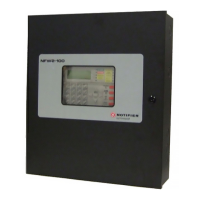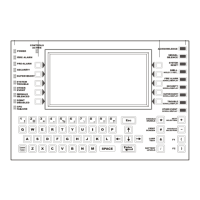
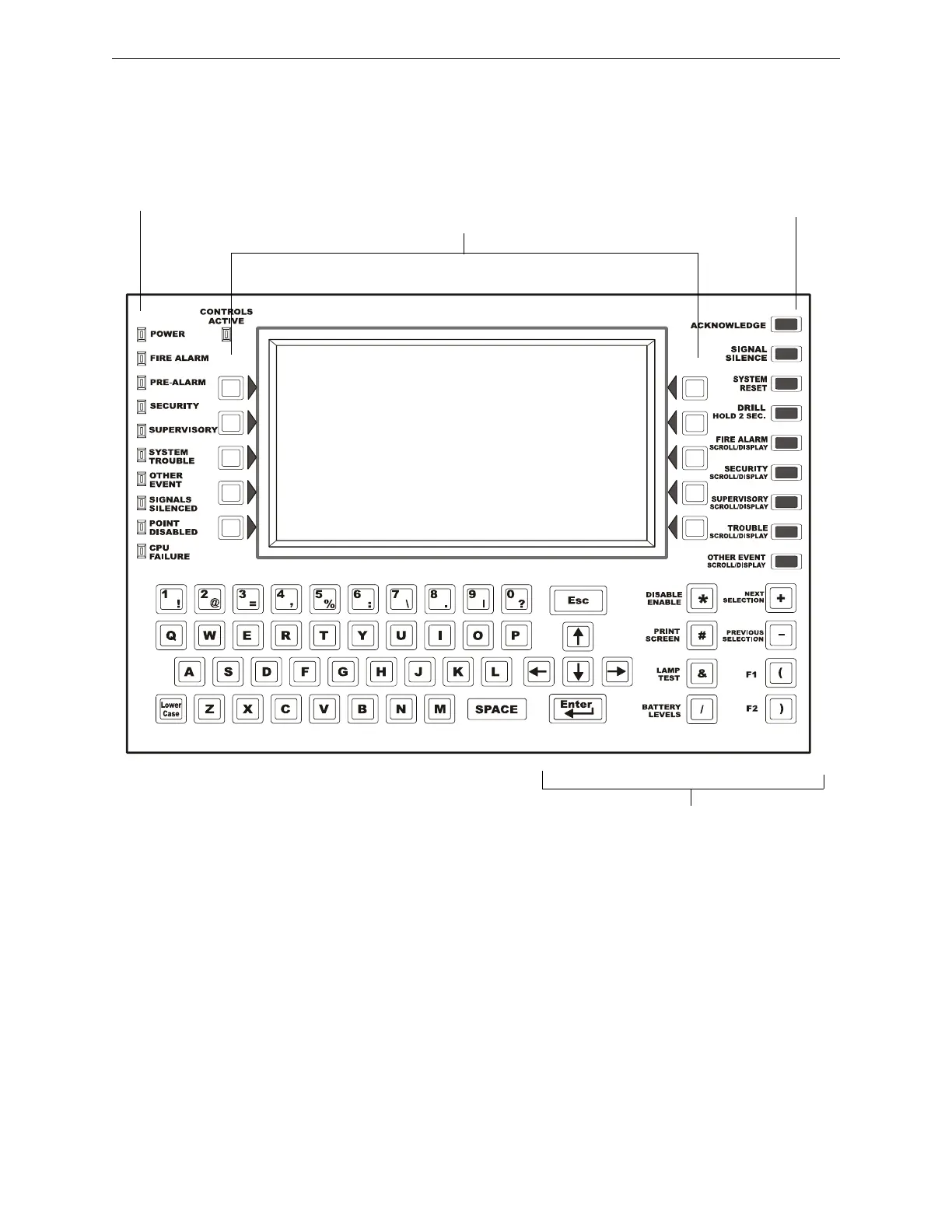
Do you have a question about the Notifier NFS2-3030 and is the answer not in the manual?
| Type | Intelligent Fire Alarm Control Panel |
|---|---|
| Power Supply (6 amps total system power) | 6 amps total system power |
| SLC Loop Voltage | 24V DC |
| NAC Voltage | 24V DC |
| Operating Temperature | 0°C to 49°C (32°F to 120°F) |
| Humidity Range | 10% to 93% non-condensing |
| Network Capability | Yes, via NOTI-FIRE-NET |
| Programming | Via VeriFire Tools |
| Power Supply | 120V or 240V AC, 50/60 Hz |
| Battery Backup | Yes |
| Communication Ports | RS-232, USB |
| SLC Loops | 1 or 2 |
| NAC Outputs | 4 |
| Operating Voltage | 24V DC nominal |
| Number of Signaling Line Circuits (SLC) | 2 |
| SLC Loop Current | 0.5 A max per loop |
| Number of Notification Appliance Circuits (NAC) | 4 |
| Total NAC Current | 6 amps |
| Number of Relays | 4 |
| Relay Contact Rating | 2.0 A @ 30 VDC |
Describes how fire alarm systems may not guarantee protection against property damage or loss of life.
Details reasons why fire alarm systems might not function adequately or provide timely warning.
Covers limitations of smoke detectors, heat detectors, and audible warning devices.
Highlights dependencies on power, compatible equipment, and communication lines.
Emphasizes the critical role of maintenance for system reliability.
Covers power disconnection before servicing and re-acceptance testing after changes.
Details environmental conditions, wiring, grounding, and protection from transients.
Advises on handling static-sensitive components and regulatory warnings.
Advises downloading the latest software version for optimal functionality.
Instructions on how to submit comments and suggestions for manual improvement.
Information regarding compliance with UL 864 9th Edition for control units.
Lists other manuals and documents providing additional system information.
Explains graphics used in the manual to indicate cautions, warnings, and notes.
Introduces the NFS2-3030 Fire Alarm Control Panel and its features.
Describes panel operation when a display/keypad is not present.
Lists core features like alarm verification, PAS, signal silence, and time-of-day controls.
Details the display/keypad for programming and viewing system information.
Describes the LCD screen's size, capabilities, and data display.
Explains the different types of keys on the keypad interface.
Categorizes keys into alphanumerics, soft keys, and fixed function keys.
Details the function of keys like ACKNOWLEDGE, SIGNAL SILENCE, and SYSTEM RESET.
Explains the purpose of special function keys for navigation and control.
Provides detailed descriptions for special function keys.
Explains the meaning and behavior of each LED indicator on the panel.
Describes the display when the system is in normal operating mode.
Details the formats for point and system events.
Illustrates and explains the components of a point event message.
Shows the display format for system trouble events.
Describes the display format for mass notification events.
Provides examples of display messages for MN alarms and troubles.
Explains how to navigate through system menus using soft keys and arrows.
Details accessing the Main Menu and its primary functions.
Describes how to view a summary of current event counts.
Shows the screen displaying counts for different event types.
Explains how to access detailed information about a specific event.
Details the information displayed in various lines of the 'More Information' screen.
Describes how to view multiple events simultaneously in a list.
Explains how to navigate and interact with the multiple event list.
Details how to select types of history events to view.
Explains how to view the current status of system points and devices.
Covers accessing menus for panel programming and status changes.
Describes how to access screens for printing reports.
Explains how the control panel monitors and reacts to system events.
Describes the panel's state and functions when no alarms are present.
Details the steps and effects of acknowledging an event.
Explains how the panel signals and displays a fire alarm.
Provides operator steps for responding to a fire alarm indication.
Guides on understanding device-specific Type ID codes in messages.
Describes how the panel indicates system or point trouble conditions.
Provides operator steps for responding to trouble indications.
Lists and describes various types of point and system troubles.
Details various point-specific troubles and their descriptions.
Details more point-specific troubles and their descriptions.
Details more point-specific troubles and their descriptions.
Details various system-level troubles and their descriptions.
Details more system-level troubles and their descriptions.
Details more system-level troubles and their descriptions.
Explains the pre-alarm function, alert vs. action settings.
Describes how the panel signals and displays a pre-alarm.
Illustrates a typical pre-alarm message displayed on the panel.
Describes how the panel signals and displays a security alarm.
Provides operator steps for responding to a security alarm indication.
Guides on understanding device-specific Type ID codes for security.
Describes how the panel signals and displays a supervisory event.
Provides operator steps for responding to supervisory indications.
Describes how the panel signals and displays a CO alarm.
Provides operator steps for responding to a CO alarm indication.
Guides on understanding device-specific Type ID codes for CO alarms.
Describes how the panel signals and displays a CO pre-alarm.
Describes how the panel signals and displays a mass notification alarm.
Provides operator steps for responding to MN alarm indications.
Describes how the panel signals and displays MN supervisory events.
Provides operator steps for responding to MN supervisory indications.
Describes how the panel signals and displays MN trouble events.
Provides operator steps for responding to MN trouble indications.
Describes how the panel indicates disabled points.
Describes panel indications for active fire control points.
Describes panel indications for active non-fire points.
Details timers for Alarm Verification, AC Fail, Silence Inhibit, Auto Silence.
Explains Presignal and Positive Alarm Sequence functionality.
The screen for selecting device types to view status.
Illustrates address formats for various device types.
Shows how to read the status of smoke detectors.
Explains the point control and status fields for detectors.
Shows how to read the status of heat detectors.
Shows how to read the status of photo/CO detectors.
Details the display of Carbon Monoxide levels for detectors.
Shows how to read the status of aspiration detectors.
Shows how to read the status of monitor modules.
Shows how to read the status of control modules.
Explains the status of control module outputs.
Shows how to read the status of general zones.
Shows how to read the status of logic zones.
Shows how to read the status of releasing zones.
Shows how to read the status of special function zones.
Shows how to read the status of trouble zones.
Shows how to read the status of annunciators.
Shows how to read the status of DAA speaker circuits.
Shows how to read the status of PAM points.
Explains the parameters for PAM points.
Describes how to view the history of system events.
Illustrates and explains the event history screen.
Allows filtering history data by a specified time and date range.
Allows filtering history data by a specified point range.
Screen for selecting the start and end points for history reports.
Explains how to access the printer functions menu.
Prints a list of detector maintenance status for installed devices.
Prints a report of installed points on the system.
Accesses the menu for printing programming configuration data.
Provides access to additional programming report options.
Screen for printing lists of active points by category.
Screen for printing reports of installed points by type.
Details reports for General, Logic, Releasing, and Special Zones.
Prints a report of installed trouble zones.
Allows selection of a range for printing installed points.
Provides an alphabetical list of device type codes and their descriptions.
Provides an alphabetical list of device type codes and their descriptions.
Provides an alphabetical list of device type codes and their descriptions.
Provides an alphabetical list of device type codes and their descriptions.
Describes releasing zones and their available programming options.
Shows an example of how cross zone selections activate releasing zones.
Lists conditions required to activate releasing zones based on cross zones.
Describes the FMM-420 module for 4-20 mA signals.
Provides an example of programming the FMM-420 for gas detection.
Details the warranty period, limitations, and conditions for products.
Outlines the procedure for submitting and processing warranty claims.
